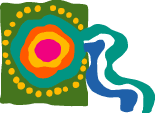
|

The collection of objects is intrinsic to the West. Indeed, the first public museums grew out of the curiosity cabinets of wealthy citizens and aristocratic princes. In settler colonies like Australia, New Zealand and Canada, collections of Indigenous culture are of immense cultural significance. The value given to collections and displays of Indigenous culture reflects changing attitudes towards Indigenous people. The 'journey to recognition' parallels the history of colonisation.
Indigenous culture was initially perceived in ethnographic terms as a 'primitive' society doomed to extinction- a footnote to the progress of European civilisation. Over the course of 200 years Aboriginal art has emerged to a position of significance. Today Indigenous and non-Indigenous curators are involved in the development of collections and displays that celebrate the diversity of Indigenous culture and its shared history with a settler colonial society.
|
|

Key concepts |
• value creation
• ethnographic artifacts
• art objects
|
|
|
 |
Read pp. 11-40,
371-380 |
|
From invisibility to value
"The early European history of Aboriginal art is a history of invisibility and denial," writes Morphy (p. 19). Early explorers and commentators often described Aboriginal art as 'crude' or 'rough'. In other cases Aboriginal art was re-ascribed to other cultures. Delays and gaps in the collection of Indigenous art occurred for many reasons, such as:
- terra nullius (the colonial idea that Australia was uninhabited land);
- evolutionism;
- ideas of primitivism (see Representations in Module 1: Aboriginality).
These changing perceptions towards Aboriginal and Torres Strait Islander art are part of the history of colonisation. Recognition for Aboriginal art went hand in hand with a growing acknowledgement of the common humanity of Aboriginal people. Collectors, artists, missionaries, anthropologists and curators all contributed to the creation of value for Aboriginal art as it has moved from a local to a global context. |
|
|

| |
How are changing perceptions to Indigenous people reflected in the collections and displays of institutions? |
|
Jones: Perceptions of Aboriginal art
Anthropologist Philip Jones traces the changing perceptions toward Aboriginal art from one governed by the ethnographic context of the museum to the aesthetic context of the art gallery. Museums initially amassed large collections of Aboriginal artefacts for display locally and overseas. But they were not seen as art. The first exhibition of Aboriginal drawings The Dawn of Art, did not take place until 1888 and another forty years elapsed before the 1929 Melbourne exhibition of Primitive Art.
Recognition for Indigenous art went hand in hand with growing interest and understanding of Indigenous culture. |
|
|

| |
How have institutions responded to meet the needs of Indigenous people? |
|
Anderson: Australian aborigines and museums...
Since the 1980s cultural institutions, in consultation with Indigenous communities, have developed new policies for the objects in their collections. Cultural materials are not just objects, they "represent relationships between people" says anthropologist Christopher Anderson.
Institutions work with Aboriginal people in the development of keeping places. These cultural centres serve as a meeting place, as a storehouse for items of material culture and historical significance and as cultural tourism outlets.
At the South Australian Museum interaction with Aboriginal communities has resulted in new policies for the collection and display of Indigenous objects: keeping places within the museum, repatriation of certain objects, family history projects and exhibitions undertaken in collaboration with Indigenous communities.
|
|
|

|
Comparing images
Compare Percy Leason's cover design from Melbourne's exhibition of Primitive Art in 1929 (Morphy, Illustration 247, p. 372) with the photograph from Magiciens de la terre in Paris in 1989 (Morphy, Illustration 249, p. 375).
What do these images tell us about the ideas and values underlying each exhibition?
Make notes and then exchange views on the Discussion Board.
|
|
|
| |
 |
 |
|
|
|